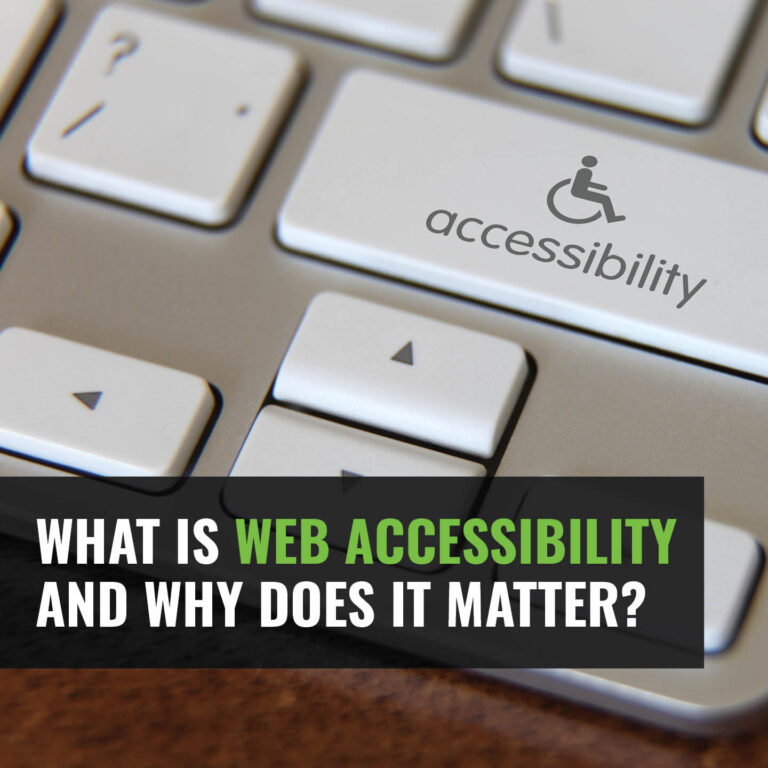What Is Web Accessibility and Why Does It Matter?

Web accessibility is a crucial area of web development that ensures websites are usable by everyone, including people with disabilities. By designing websites that accommodate all users, you not only comply with legal requirements but also enhance your site’s reach and usability. This inclusivity is crucial where the internet is a vital resource for information, services and social interaction.
Why Web Accessibility Is Important
- Inclusivity and Equality: Making a website accessible ensures that people with disabilities can access information and services just like anyone else. This includes individuals with visual, auditory, cognitive or motor impairments.
- Legal Compliance and Risks: Many countries have legal requirements for web accessibility. In the United States, the Americans with Disabilities Act (ADA) mandates that websites be accessible to people with disabilities. Ignoring these requirements can result in significant legal risks, including lawsuits and fines, which can damage your company’s reputation and financial stability.
- Improved User Experience: Ensuring accessibility best practices are met often enhances the overall user experience. For example, strong contrast and clear navigation benefit everyone, not just those with disabilities. An accessible website creates a smoother more intuitive experience for all users making it easier for everyone to navigate and interact with your site.
- SEO Benefits: Accessible websites are often better optimized for search engines. Features like alt text for images, clear headings and descriptive links can improve your search engine rankings, driving more traffic to your site. Additionally, semantically correct code needed for screen readers also helps search engine crawlers understand your website and its content.
- Building Brand Reputation: By prioritizing accessibility, you demonstrate a commitment to inclusivity and user satisfaction. This can enhance your brand’s reputation, fostering trust and loyalty among your audience. This can differentiate your brand in a competitive market.
- Expanding Market Reach: An accessible website opens your business to a broader audience. By accommodating the needs of people with disabilities, you tap into a significant and often overlooked market segment, potentially increasing your customer base and driving business growth.
Evaluating Your Website’s Accessibility
Unless you are a developer or take a specific interest in promoting an inclusive web, the Web Content Accessibility Guidelines (WCAG)1 below may be a bit too much. In that case, you can ask yourself some of the following basic questions:
- Are there inclusive alternatives to all audio and visual assets on my website?
- Are the color contrasts and font sizes on my website accommodating to users with varying levels of vision? It is a little-known fact that approximately 8% of men are colorblind.2
- Would users with specific technology requirements still be able to access my site and navigate it effectively?
If you don’t know the answer to any of those questions or the answer is no, it may be time to evaluate the accessibility of your website.
Key Guidelines for Web Accessibility
Web accessibility is guided by the Web Content Accessibility Guidelines (WCAG)1 developed by the World Wide Web Consortium (W3C). The latest standard, WCAG 2.2, released in 2021, should now be used by default to ensure compliance. Here are some key guidelines:
- Perceivable: Information and user interface components must be presentable to users in ways they can perceive. This includes providing text alternatives for non-text content, such as images and videos.
- Operable: User interface components and navigation must be operable. This means that all functionality should be accessible via a keyboard and that users have enough time to read and use the site.
- Understandable: Information and the operation of the user interface must be understandable. This involves making text readable and predictable, and providing input assistance when necessary.
- Robust: Content must be robust enough to be interpreted reliably by a wide variety of user agents, including assistive technologies. This means using standard-compliant HTML and ensuring compatibility with current and future tools.
Maintaining Web Accessibility
Automated testing and monitoring tools can help identify and address many accessibility issues. However, these tools can miss more nuanced problems that require manual audits and technical fixes. Expert audits ensure that all aspects of your website are evaluated, including complex interactions and subtle issues.
To maintain a great user experience and ensure compliance, consider regular accessibility audits of your website with ongoing automated testing. A program like this can help to identify and resolve issues quickly, keeping your site accessible and engaging for all users.
Should I Use an Accessibility Overlay?
Accessibility overlay tools are automated solutions that claim to detect and fix web accessibility issues. While they can address some basic problems, they often do not resolve deeper issues in your site’s source code. Relying on overlays as a long-term solution can leave you open to legal risk and provide a false sense of security. Additionally, overlays can hurt web performance and site speeds. They can also break from a variety of technical issues or billing/subscription issues. Overlays should be seen as supplementary offerings, not a replacement for comprehensive accessibility efforts.
Conclusion
Prioritizing web accessibility is not just about meeting legal obligations; it’s about creating a better experience for all users. An accessible website creates a smoother, more intuitive experience for everyone, making it easier to navigate and interact with your site. By adhering to current guidelines and regularly updating your site, you ensure that everyone can access and enjoy your services. This approach not only enhances your brand’s reputation but also expands your market reach and drives business growth.
Disclaimer: This article is meant to be used for informational purposes only. This article should not be interpreted as legal advice.
This article was previously published on February 12, 2019, and updated on June 7, 2024.
Sources:

